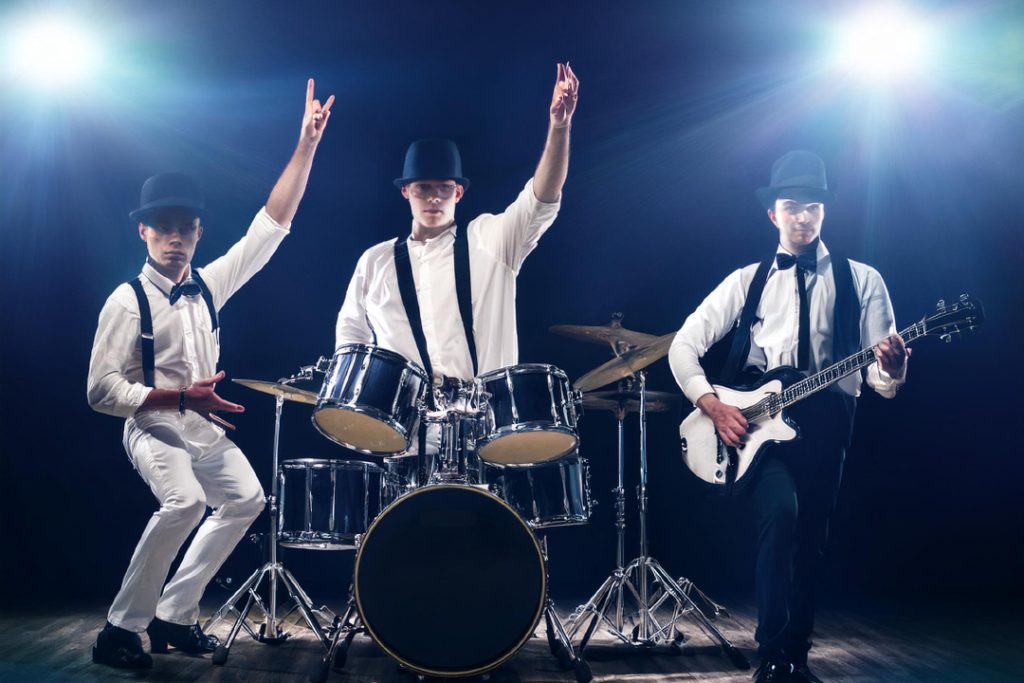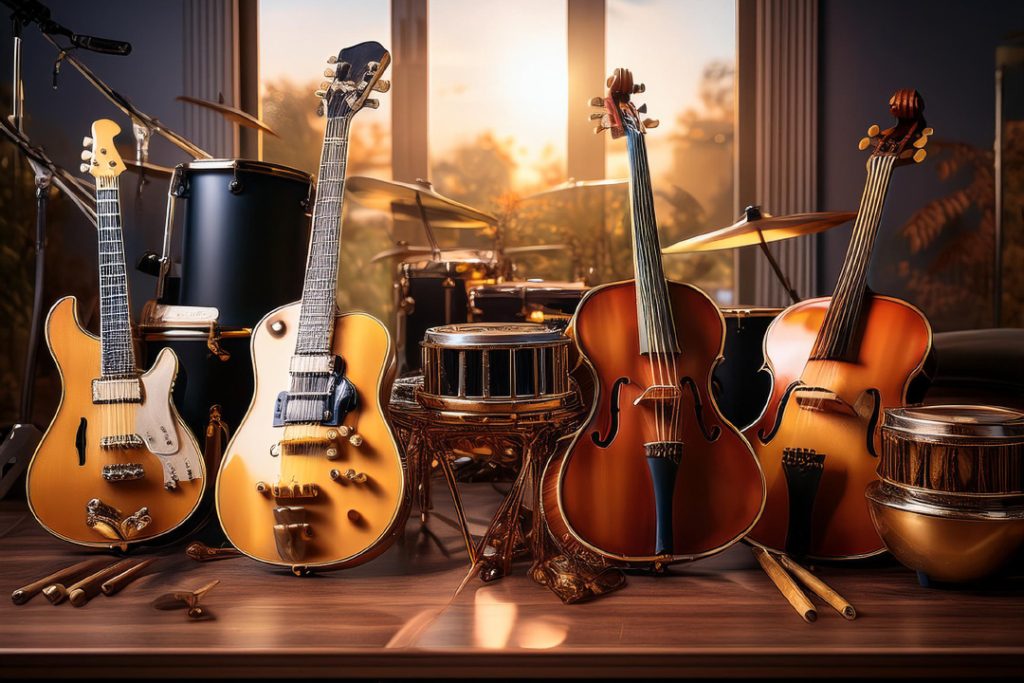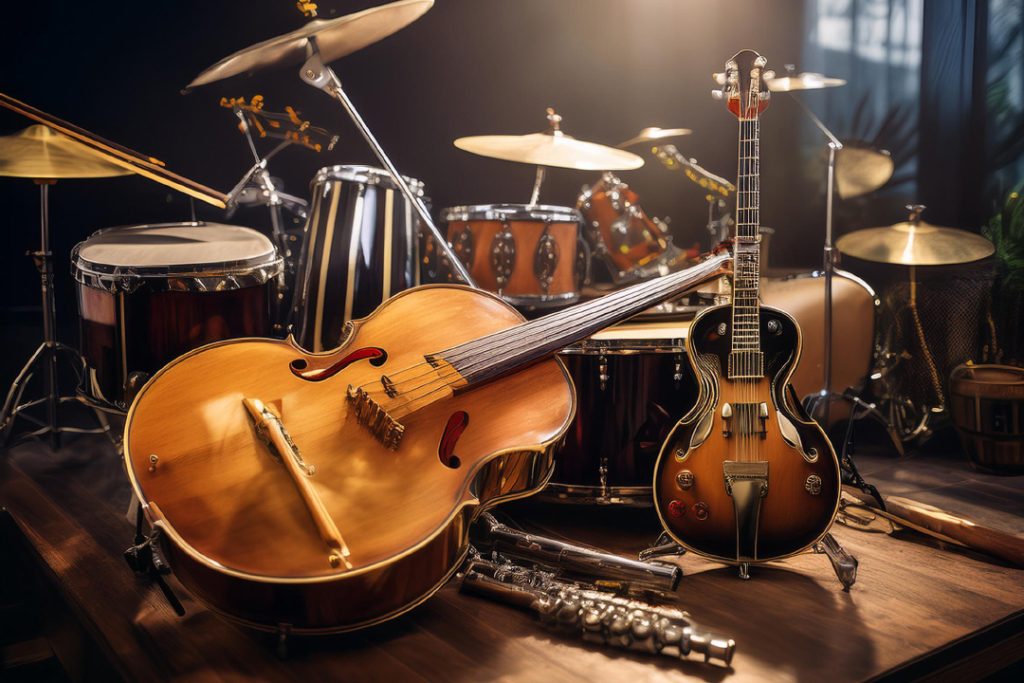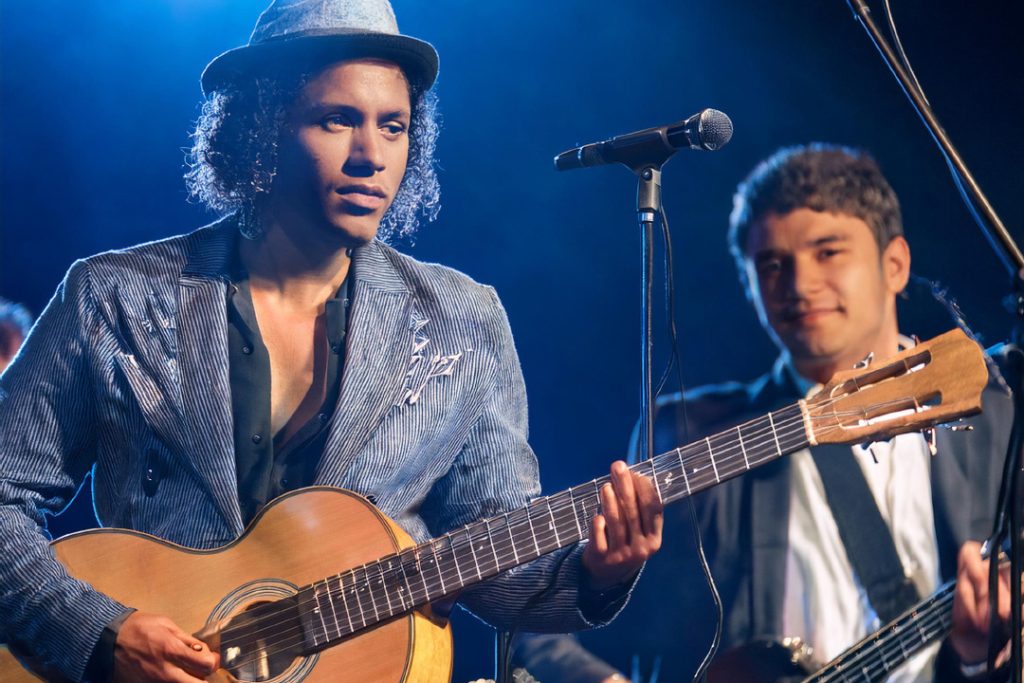Birth of Rock and Roll
Rock and Roll, a genre that kicked the music scene into overdrive, traces its roots to an epic mash-up of blues, jazz, country and gospel.
Blues and Jazz: The Powerhouses
Blues, with its gut-wrenching stories and soulful riffs, became the bedrock of rock and roll. Picture this: heartfelt lyrics paired with raw, down-to-earth melodies. It’s that depth and honesty in blues that laid down the rebellious streak we’d come to love in rock and roll.
Jazz, on the other hand, tossed in a cocktail of improvisation and frenetic energy. Jazz wasn’t about playing it safe; it was about pushing buttons, breaking molds. This experimentation seeped into rock and roll, fueling a vibe full of surprises and fresh beats.
Putting blues and jazz in the same room birthed a sound that was both groundbreaking and gripping. A match made in music heaven, really.
Striking a Chord: The Genesis of Rock and Roll
This new sound hit the sweet spot in the mid-1950s. Think Chuck Berry, Little Richard, and Elvis Presley. These trailblazers weren’t just making music—they were scripting a whole new cultural chapter. Their charismatic performances and unforgettable tracks were a lightning rod, with fans around the globe getting hooked.
Rock and roll caught fire and turned into more than a genre; it morphed into a movement, a phenomenon that broke societal norms and united people from all corners. It’s not just about the music—rock and roll’s heartbeat is about passion, innovation, and the freedom to raise a ruckus.
From its bluesy, jazzy roots, rock and roll flourished, swaying the fate of music history, leaving us with a legacy that keeps on rocking today. The genre’s DNA is in practically every contemporary beat, proving that the spirit of those early days lives on, cranked up to eleven.
Rock and roll didn’t just influence music; it rebooted our culture, setting off shockwaves that still ripple through the airwaves, inspiring today’s artists and fans alike. Rock on!
Rock and Roll: The Soundtrack of the 1950s
When the 1950s rolled around, so did a fresh, lively wave of music called rock and roll. This was the decade where many legends stamped their mark, giving life to a sound that would shape the future of music and culture.
Trailblazers of Rock and Roll
The ’50s saw the birth of rock and roll, with legends like Chuck Berry, Little Richard, and Elvis Presley leading the charge. These guys brought a new kind of electricity to the stage with their spirited performances and inventive melodies, catching the attention of fans everywhere.
Chip Berry’s guitar riffs, Little Richard’s piano prowess, and Elvis’ swiveling hips—they weren’t just making music, they were creating a movement. These artists took bits of rhythm and blues, gospel, and country, mixing them into a sound that spoke straight to the youthful heart. Their impact didn’t stop at just influencing music; they cracked open new doors for other musicians to follow and experiment with.
Shaking Up Society and Culture
Rock and roll in the ’50s was more than just tunes; it was a symbol of rebellion, freedom, and new ways of thinking. The energetic beats, daring lyrics, and wild performances were a kick against the norms that had ruled for so long. Teenagers of the era found a voice in rock and roll, a way to push back against the staid traditions of their parents.

A huge part of rock and roll’s magic was how it drew from and gave back to different communities. Artists like Chuck Berry and Little Richard didn’t just cross musical boundaries—they demolished racial ones too. Their success with both Black and white audiences signaled the start of an art form that welcomed diversity.
Beyond the music itself, rock and roll was a full-on cultural bomb. Fashion, art, and attitude trends all took cues from its biggest stars. Next thing you know, everyone wanted to dress like Elvis, dance like Little Richard, and live with the same edge and flair.
Rock and roll’s roots in the ’50s set it up to thrive and evolve across the decades that followed. It wasn’t a flash in the pan—it was the start of something that continues to influence artists and inspire fans like no other genre. If you’re curious about how rock and roll has changed over the years, check out our detailed rock and roll timeline to see all the key moments and milestones.
The 1960s and 1970s: The Golden Heyday
Back in the ’60s and ’70s, rock and roll wasn’t just a genre—it was a full-blown revolution, shaking the world and giving rise to sounds and legends that still echo today.
Rock and Roll’s Radical Sound Shift
The ’60s and ’70s saw rock and roll get a makeover, with bands throwing the rule book out the window. They mixed in folk, psychedelic vibes, and blues, creating a sound that was wild and varied.
| Decade | Vibes |
|---|---|
| 1960s | Psychedelic rock, folk rock, and experimental jams |
| 1970s | Hard rock, prog rock, and heavy metal |
This time was all about concept albums, epic guitar solos, and crazy musical experiments that mirrored the era’s social upheaval. Bands dialed up their songwriting and production chops, cranking out songs that still hit different even today.
Legends of the Stage and Studio
The ’60s and ’70s pumped out some massive names in rock and roll, shaping music forever. These trailblazers didn’t just play music; they created legacies.
Iconic Bands
- The Beatles: Changed everything with mind-blowing songwriting and studio wizardry.
- The Rolling Stones: Mixed rock, blues, and R&B into something raw and unforgettable.
- Led Zeppelin: Made hard rock and heavy metal a thing, complete with killer live shows and complex tracks.
Iconic Artists
- Jimi Hendrix: Took the electric guitar to new heights—his skills are still unmatched.
- Janis Joplin: With her gritty and soulful voice, she became the queen of psychedelic rock.
- David Bowie: Forever changing his sound and look, Bowie was a true rock chameleon, leaving an everlasting mark.
These rock icons filled radios, arenas, and the hearts of generations, laying down tracks that future musicians would follow. Rock today still feels their touch, proving their art was more than just music—it was magic.
The 1980s and 1990s: Rock’s Glitter and Grit
As rock and roll jammed through the 1980s and 1990s, it blossomed with flavors as unique as a record store bargain bin. This time wasn’t just about great bands—it was about innovation, technology, and mixing things up.

Subgenres That Rocked
These decades birthed some zesty subgenres, all cranking out vibes that left lasting echoes. What was your cup of tea? Wild hair metal anthems? Intense grunge riffs? Pogo-worthy punk? Or maybe the quirky beats of alternative rock? Whatever your style, the scene was buzzing with creativity.
| Subgenre | Vibe Check |
|---|---|
| Alternative Rock | Embraced weird sounds and experiments |
| Grunge | Hard-hitting noise with soulful, deep lyrics |
| Hair Metal | Flashy fashion meets epic guitar solos |
| Punk Rock | Fast, raw, and yelling at “The Man” |
And it wasn’t just about sticking to one lane. Bands started mixing rock with pop, hip-hop, and electronic beats. If you were listening, you were hearing some slick new soundscapes that made you dance, mosh, or just zone out in wonder.
Tech That Changed the Game
Rock ain’t stuck in the Stone Age. The ’80s and ’90s brought all sorts of tech goodies. Digital recording got folks hefty sound quality without the hiss and crackle. MIDI and synthesizers? They allowed musicians to tweak and create sounds that were pure ear candy.
| Tech Toy | Game Changer |
|---|---|
| Digital Recording | Slicker sound and easier edits |
| MIDI Gear | Crazy control over every blip and beep |
| Synths | Added layers of funky, out-there textures |
Then came the music video. MTV turned the dial from radio to video starland. It wasn’t just what you heard; it was about what you saw. Suddenly, bands had to look good doing their thing too. It opened a whole new dimension for artists to connect with fans.
This era wasn’t just a footnote; it was a powerhouse. With genres blending like a smooth milkshake and tech opening new frontiers, rock pushed past old limits and kept evolving. Through plaid shirts, teased-up hair, guitars, and synths, the ’80s and ’90s truly smashed the “same old, same old” in rock.
The 2000s to Today: Rocking the Globe and Going Digital
As the new millennium kicked in, rock music kept morphing, winning fans worldwide and grooving into the digital crowd. Major shifts happened, turning rock music global and adding digital perks to the mix.
Rock Music Goes Global
The 2000s were big for rock music as bands from every nook and cranny started making waves. Thanks to the internet boom and streaming platforms, sharing music worldwide became a cinch. Rock music wasn’t just crossing borders; it was uniting fans everywhere.
As rock music went global, we got a wild mix of subgenres. Traditional rock vibes started blending with local beats, creating fresh and exciting sounds. Curious about these funky fusions? Check out our piece on blues music genres to get the scoop.
The Comeback and What’s Hot Now
Since the 2000s, rock music’s been making a grand comeback. Both old-school legends and new faces have been giving the genre fresh twists. The digital era opened up cool ways for musicians to reach their fans, share their tunes, and get creative.
Tech has seriously jazzed up how rock music sounds today. From digital recording tools to slick effects, musicians are breaking new ground. Wanna geek out on how tech has shaped modern rock? Peek at our article on rock music origins.
These days, rock music’s all about shaking things up. Artists are mixing genres, trying out quirky instruments, and exploring offbeat themes. Whether it’s indie rock or alternative vibes, the variety keeps drawing in listeners and sparking the next wave of rock stars.
Rock and roll’s still owning the global stage, embracing all things digital while staying true to its roots. Its powerful influence keeps rocking the world of music, pushing creative limits and inspiring both icons and newbies. For a dive into rock’s epic journey, hit up the rock and roll timeline and relive the game-changing moments that made this genre legendary.
Rock and Roll Legacy
When you think of rock and roll, it’s hard not to feel the genre’s impact that still shakes the music scene today. So, let’s get real about how rock and roll changed everything and why it still matters.
Rock and Roll’s Stamp on Music History
Rock and roll didn’t just show up one day—it exploded. Coming from the gritty sounds of blues and jazz, it brought a fresh, loud, and rebellious vibe in the 1950s. The electric guitar screeched, drum beats pounded, and audiences went wild. This wasn’t just music; it was a revolution.

The greatest impact? It broke the rules. Artists weren’t sticking to tidy societal expectations anymore—they were smashing them. Rock and roll opened doors for musicians to voice out on politics, personal freedom, and social change. This raw, unrestricted expression caught fire worldwide.
Here are some game-changers who made rock and roll what it is:
| Artist | Contribution |
|---|---|
| Elvis Presley | The trailblazer of rockabilly, crowned the “King of Rock and Roll.” |
| The Beatles | Shook things up with groundbreaking tunes and lyrics. |
| Led Zeppelin | Took hard rock to a new level with their electrifying gigs and unforgettable tracks. |
Today’s Tunes with a Rock and Roll Soul
Rock and roll isn’t just nostalgia; it’s alive and kicking even today. You can feel its pulse in the beats, the melodies, and the raw emotions of modern music. Alternative bands like Arctic Monkeys and The Strokes take that rock and roll defiance and make it their own, creating powerful anthems that scream authenticity.
And it’s not just rock. You hear rock’s edge in hip-hop beats, pop rhythms, and electronic vibes. This genre-bending jam session keeps the spirit of rock and roll fresh and exciting.
Modern artists don’t just mimic their rock idols—they revere them. They mix in iconic styles and rebellious attitudes, ensuring rock and roll’s untamed spirit roars on. It’s a musical shout-out that keeps the legend alive and kicking, no matter the genre.
So, as we blast into the future, rock and roll’s legacy reminds us that music isn’t just about playing notes; it’s about pushing boundaries, shaking up the status quo, and striking a chord with our deepest emotions.
Here some recommended links selected for you: The Best Books of the Month, Todays best Deals at Amazon, Best Sellers in Cell Phones & Accessories and last but not least the easy and great way to send a gift for the holidays: Amazon.com eGift Card (Instant Email or Text Delivery).



